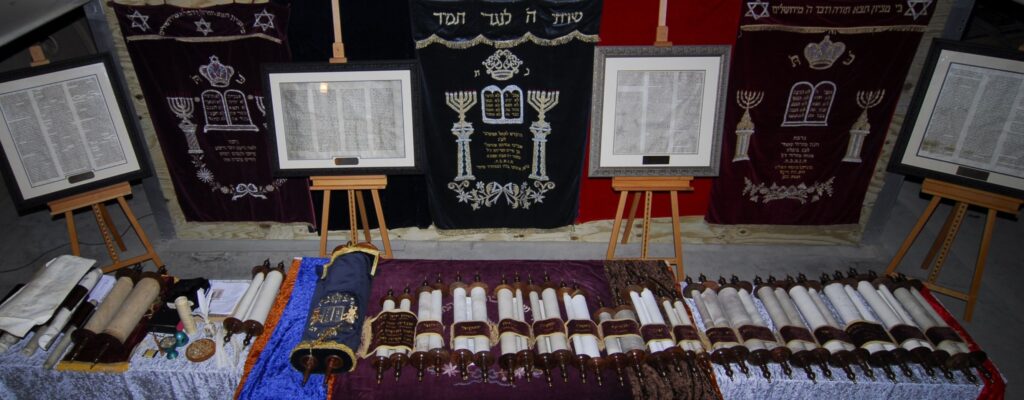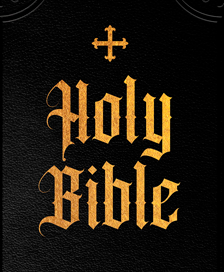Hebrew Bible, The Jewish Bible, Tanakh
The Holy Scriptures

Contents
Preface
Glossary for the Footnotes
Torah (The Pentateuch)
Bereshit (Genesis)
Shemot (Exodus)
Vayikra (Leviticus)
Bamidbar (Numbers)
Devarim (Deuteronomy)
Nevi’im (Prophets)
Yehoshua (Joshua)
Shoftim (Judges)
Shmuel I (I Samuel)
Shmuel II (II Samuel)
Melachim I (I Kings)
Melachim II (II Kings)
Yeshayahu (Isaiah)
Yirmiyahu (Jeremiah)
Yechezkel (Ezekiel)
The Twelve Minor Prophets
Hoshea (Hosea)
Yoel (Joel)
Amos
Ovadiah (Obadiah)
Yonah (Jonah)
Michah (Micah)
Nachum (Nahum)
Chavakuk (Habakkuk)
Tzefaniah (Zephaniah)
Chaggai (Haggai)
Zechariah
Malachi
Ketuvim (Scriptures)
Tehillim (Psalms)
Mishlei (Proverbs)
Iyov (Job)
Shir Hashirim (Song of Songs)
Rut (Ruth)
Eichah (Lamentations)
Kohelet (Ecclesiastes)
Esther
Daniel
Ezra
Nechemiah (Nehemiah)
Divrei Hayamim I (Chronicles I)
Divrei Hayamim II (Chronicles II)
Tanakh
The Holy Scriptures
The Tanakh is an entirely original translation of the Holy Scriptures into contemporary English, based on the Masoretic—the traditional Hebrew—text.
It is the culmination of three decades of collaboration by academic scholars and rabbis representing the three largest branches of organized Judaism in the United States.
Not since the third century B.C.E., when seventy-two elders of the tribes of Israel created the Greek translation of the Holy Scriptures, known as the Septuagint, has such a broad-based committee of Jewish scholars produced a major Bible translation.
In executing this monumental task, the translators made use of the entire range of biblical interpretation, ancient and modern, Jewish and non-Jewish. They drew upon the latest findings in linguistics and archeology as well as the work of early rabbinic and medieval commentators, grammarians, and philologians. The resulting text is a triumph of literary style and biblical scholarship, unsurpassed in accuracy and clarity.
The New JPS Translation
According to the Traditional Hebrew Text
Preface
This translation of Tanakh, the Holy Scriptures, produced by the Jewish Publication Society, was made directly from the traditional Hebrew text into the idiom of modern English. It represents the collaboration of aca- demic scholars with rabbis from the three largest branches of organized Jewish religious life in America. Begun in 1955, the ongoing translation was published in three main stages: The Torah in 1962, The Prophets (Nevi’im) in 1978, and The Writings (Kethuvim) in 1982. These three volumes, with revisions, are now brought together in a complete English Tanakh (Torah-Nevi’im-Kethuvim), the latest link in the chain of Jewish Bible translations.
On the History of Bible Translation
Bible translation began about 2,200 years ago, in the third century B.C.E., as the large Jewish population of Alexandria, Egypt, came under the in- fluence of Hellenism. When the Greek language replaced Hebrew and Aramaic as their vernacular, and the Torah in its Hebrew original was no longer commonly understood, a translation into Greek was made for the Jewish community of Alexandria. This translation came to be known as the Septuagint, Latin for “seventy,” because of the legend that the com- mittee of translators numbered seventy-two, six elders from each of the twelve tribes of Israel.
In the last few centuries B.C.E., the Jews who lived to the north and east of Judea also found the Hebrew Bible difficult to understand, for their spoken language had become largely Aramaic. Translations into Ar- amaic, first of the Torah and then of the rest of the Bible, became known as the Targums.
The Septuagint and the Targums are not only the oldest translations of the Bible but also the most influential. Down to our own day, virtually every Christian translation has followed the methods of the Jewish translators who created the Septuagint, and generally followed their renderings of the Hebrew as well. The Christian translators also were influenced by the interpretation of the Hebrew text set forth in the Targums (much of it in oral form at the time) and by the writings of the Jewish philosopher- interpreter Philo of Alexandria (died about 45 C.E.).
The forerunners and leaders of the Renaissance and the Reformation (fourteenth-fifteenth centuries), and especially Martin Luther and William Tyndale (sixteenth century), made use of Latin translations of the classic Jewish commentators Rashi, Ibn Ezra, and Kimhi (eleventh-thirteenth centuries), whose works were imbued with the direct knowledge of the Targums.
Luther was greatly indebted to Nicholas of Lyre (1270–1349), who had adopted Rashi’s exegesis for his Latin Bible commentary. Rashi’s influence on all authorized and most unofficial English translations of the Hebrew Bible becomes evident when Tyndale’s dependence on Luther is considered. Tyndale is central to many subsequent English translations: the King James Version of 1611, the (British) Revised Version of 1881–1885, the American Standard Version of 1901, and especially the Revised Standard Version of 1952.
Alongside the close, literal method of Bible translation, the earliest Jewish translators were also influenced by the widely held view that, along with the Written Law (torah she-biktav), God had given Moses on Mount Sinai an Oral Law (torah she-be‘al peh) as well; so that to comprehend God’s Torah fully and correctly, it was essential to make use of both.
Thus, when a translation of the Hebrew Bible into the Judeo-Arabic vernacular was deemed necessary for Jewry in Moslem countries toward the end of the first millennium, the noted philologian, philosopher, and community leader Saadia Gaon (882–942) produced a version that in- corporated traditional Jewish interpretation but was not based on word- for-word translation; at the same time, it was a model of clarity and stylistic elegance. The present version is in the spirit of Saadia.
With the growth of Christianity in the first century, the Church adopted the Septuagint as its Bible, and the Septuagint was translated into the languages of the various Christian communities. As Greek began to give way to Latin in the Roman Empire, it was only a matter of time before a Latin translation of Scripture became the recognized Bible of the Church. The Church father Jerome (c. 340–420) produced the official Latin ver- sion.
Drawing on Jewish tradition and consulting Jewish teachers, he achieved what came to be known as the Vulgate, the Bible in the language of the common people. The Vulgate, the Bible of European Christianity until the Reformation, is clearly the most significant Bible translation after the Septuagint.
With the rise of Protestantism in Europe, scholars within this move- ment set themselves the task of making the Bible available in the various vernaculars of the time. By 1526 the first parts of two notable translations began to appear: Martin Luther’s in German and William Tyndale’s in English. The latter, by way of several subsequent revisions, became the King James Version of 1611. The more modern English versions—such as The Holy Scriptures by the American rabbi Isaac Leeser (1855), the (British) Revised Version (1881–1885), the American Standard Version (1901), the Jewish Publication Society’s The Holy Scriptures (1917), and the (American) Revised Standard Version (1952)—made extensive use of the King James.
On the Making of the New Translation
After World War II, when the Jewish Publication Society began to con- sider a new edition of the Bible, the idea of a modest revision of the 1917 translation met with resistance, and the concept of a completely new translation gradually took hold. The proposed translation would repro- duce the Hebrew idiomatically and reflect contemporary scholarship, thus laying emphasis upon intelligibility and correctness. It would make critical use of the early rabbinic and medieval Jewish commentators, grammari- ans, and philologians and would rely on the traditional Hebrew text, avoiding emendations. The need for this new translation was the focus of the Jewish Publication Society’s annual meeting in 1953. Later that year the Society announced its intention to proceed with the project, and in 1955 the committee of translators began their task.
Harry M. Orlinsky, Professor of Bible at Hebrew Union Col- lege–Jewish Institute of Religion (New York), was asked to serve as ed- itor-in-chief for the new translation, along with H. L. Ginsberg, Professor of Bible at the Jewish Theological Seminary, and Ephraim A. Speiser, Professor of Semitic and Oriental Languages at the University of Penn- sylvania, as fellow editors. Associated with them were three rabbis: Max Arzt, Bernard J. Bamberger, and Harry Freedman, representing the Con- servative, Reform, and Orthodox branches of organized Jewish religious life. Solomon Grayzel, editor of the Jewish Publication Society, served as secretary of the committee.
The committee profited much from the work of previous translators; the present rendering, however, is essentially a new translation. A few of its characteristics may be noted. The committee undertook to follow faith- fully the traditional Hebrew text, but there were certain points at which footnotes appeared necessary:
(1) where the committee had to admit that it did not understand a word or passage;
(2) where an alternative ren- dering was possible;
(3) where an old rendering, no longer retained, was so well known that it would very likely be missed, in which case the traditional translation was given in the name of “Others” (usually referring to the Society’s version of 1917);
(4) where the understanding of a pas- sage could be facilitated by reference to another passage elsewhere in the Bible; and (5) where important textual variants are to be found in some of the ancient manuscripts or versions of the Bible.
The translators avoided obsolete words and phrases and, whenever pos- sible, rendered Hebrew idioms by means of their normal English equiv- alents. For the second person singular, the modern “you” was used instead of the archaic “thou,” even when referring to the Deity (“You”). A further obvious difference between this translation and most of the older ones is in the rendering of the Hebrew particle waw, which is usually translated “and.” Biblical Hebrew demanded the frequent use of the waw, but in that style it had the force not only of “and” but also of “however,” “but,” “yet,” “when,” and any number of other such words and particles, or none at all that can be translated into English. Always to render it as “and” is to misrepresent the Hebrew rather than be faithful to it. Consequently, the committee translated the particle as the sense required, or left it un- translated.
The chapter and verse divisions found in the printed Bible are
